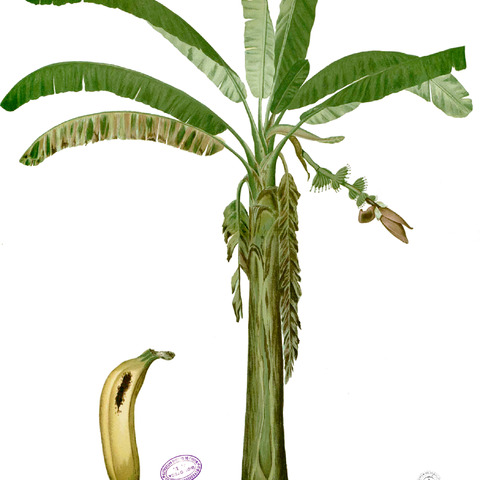Treelike herbs, perennial, from corm [rhizome] [corm]. True aerial stems absent. Leaves basal, in several ranks, differentiated into basal sheath, petiole, and blade; sheaths overlapping, forming unbranched pseudostem, open, ligule absent; summit of petiole not differentiated; blade with lateral veins parallel, diverging from prominent midrib. Inflorescences 1 per aerial shoot, projecting from tip of pseudostem, pedunculate racemes of 12--20-flowered monochasial cymes (cincinni); bracts of main axis enclosing cincinni. Flowers unisexual (proximal flowers pistillate, distal flowers staminate), bilaterally symmetric; sepals and petals differentiated, sepals 3, petals 3, 3 sepals and 2 petals fused, remaining petal distinct; fertile stamens 5(--6), not petal-like; anthers 2-locular; occasionally 1 rudimentary staminode; ovary inferior, 3-carpellate, 3-locular, all locules fertile; placentation axile; ovules many per locule; style terminal, filiform; stigma 3-lobed. Fruits berries; sepals not persistent in fruit. Seeds: aril absent; endosperm copious; perisperm copious; embryo straight. x = 9, 10, 11.
Giant herbs from a branched or unbranched corm-like rootstock. Leaves arising from the apex of the corm, spirally arranged, very large; leaf-sheaths elongated, densely imbricate and forming a cylindrical pseudostem; lamina oblong, with a strongly channelled midrib and very many pinnately-arranged parallel lateral veins. Inflorescence terminal on the corm, growing up through the centre of the pseudostem and thus appearing to arise from its apex. Flowers unisexual, those on the proximal parts of the inflorescence ?, on the distal ?, borne in condensed groups subtended by spathaceous bracts. Calyx spathaceous, splitting down one side, with ± 3 teeth at the apex. Corolla lobes 3, 2 of them adnate to the calyx-tube, the third separate and directed downwards. Stamens 6, but one usually rudimentary; filaments terete, thin; anthers dithecous with parallel thecae. Ovary inferior, 3-locular; placentation axile; ovules many. Fruit a large elongated fleshy 3-locular berry containing, in the wild species, numerous very hard subspherical seeds containing a straight embryo and copious endosperm
Herbs perennial or monocarpic, growing from sympodial rhizomes or a massive, sympodial corm. Pseudostems composed of closely packed leaf sheaths. Leaves spirally arranged, petiolate; leaf blade entire, pinnately veined. Inflorescence terminal or rarely axillary, cymose. Bracts spirally arranged, often brilliantly colored, spathelike, large. Flowers bisexual or unisexual by abortion, zygomorphic. Perianth in 2 whorls; 3 outer tepals and 2 inner ones united into a compound tepal; third inner tepal free. Stamens 5, free; anthers 2-loculed. Pistil 1; ovary inferior, 3-loculed; ovules numerous per locule, anatropous; placentation axile. Style simple or capitate. Fruit a berry, fleshy or leathery and dry, indehiscent. Seeds hard, not arillate; embryo straight, surrounded by a ± well-developed endosperm and a mealy perisperm.
Flowers mostly unisexual, clustered and subtended by large green spathaceous bracts, the male flowers within the upper bracts, the female within the lower
Stamens 5 perfect, with a rudimentary sixth, or 6 perfect; filaments filiform; anthers 2-locular, the loculi parallel and contiguous
Calyx elongated, at first narrowly tubular, soon splitting on one side, variously toothed at apex
Leaves spirally arranged, very large, with a thick midrib and numerous pinnately parallel nerves
Ovary inferior, 3-locular; ovules numerous, axile; style filiform, with a lobulate stigma
Seeds with a thick hard testa and straight embryo in copious endosperm
Stems formed by the imbricate bases of the petioles, erect
Fruit fleshy, indehiscent, 3-locular
Corolla more or less 2-lipped

